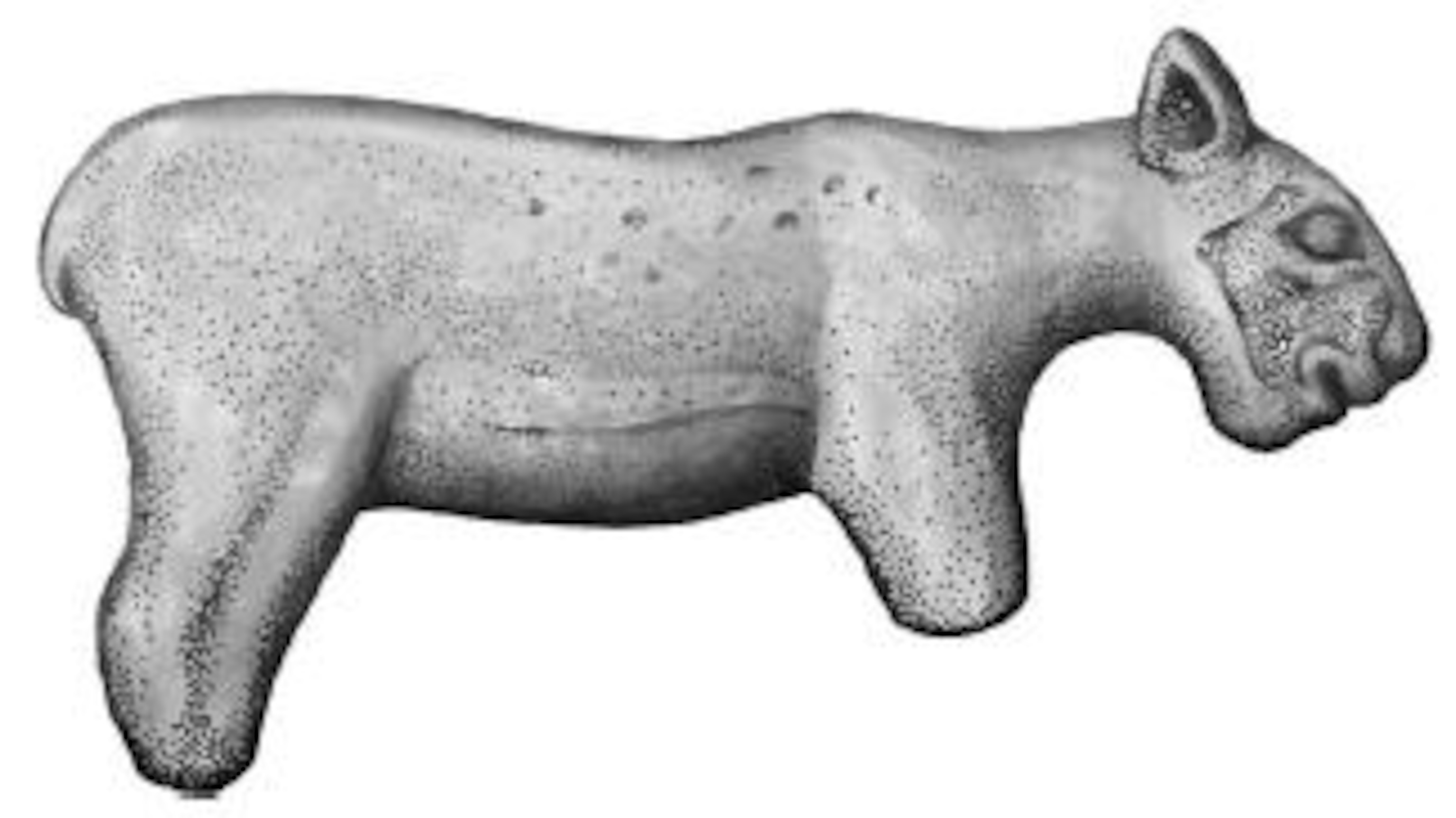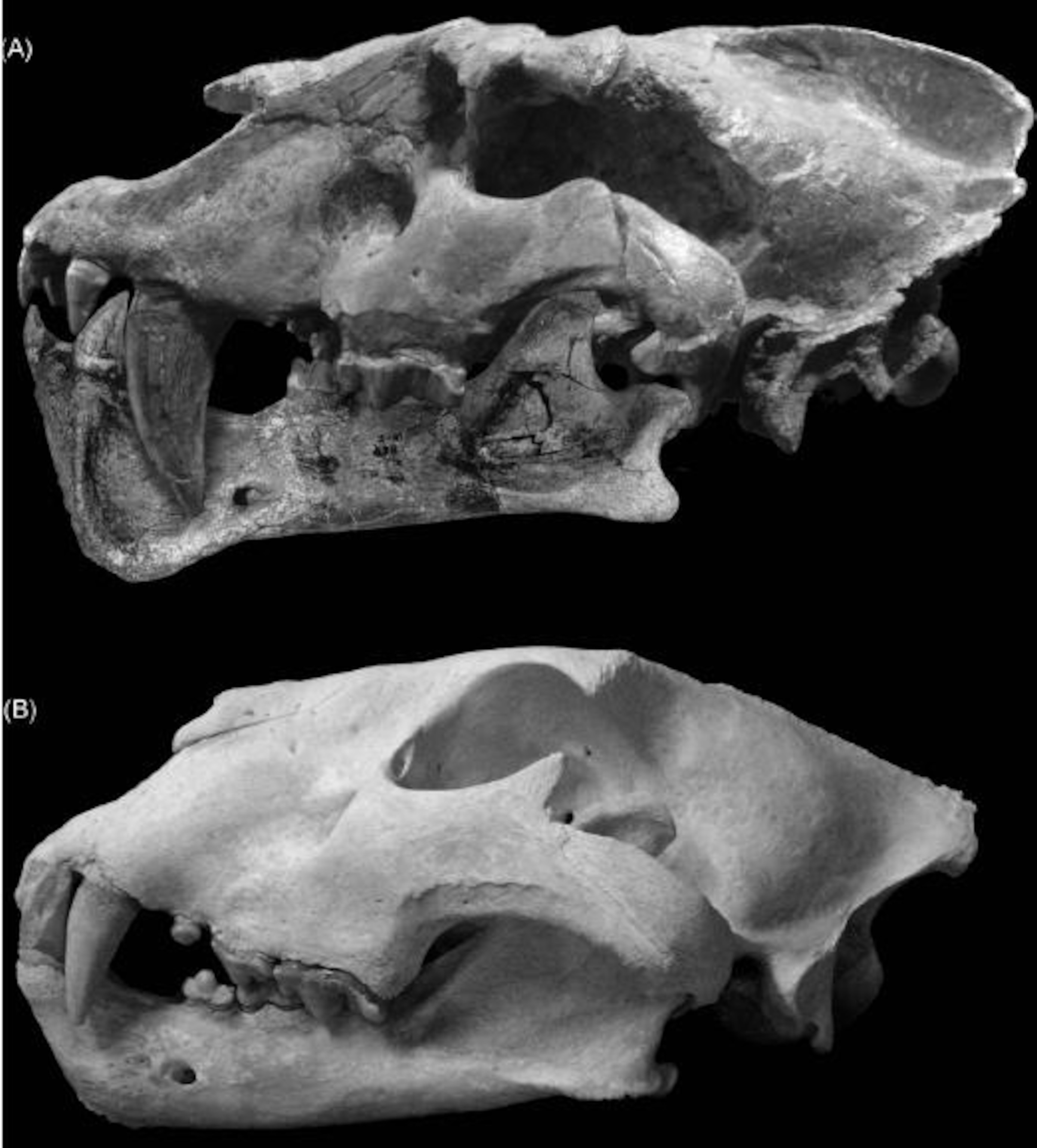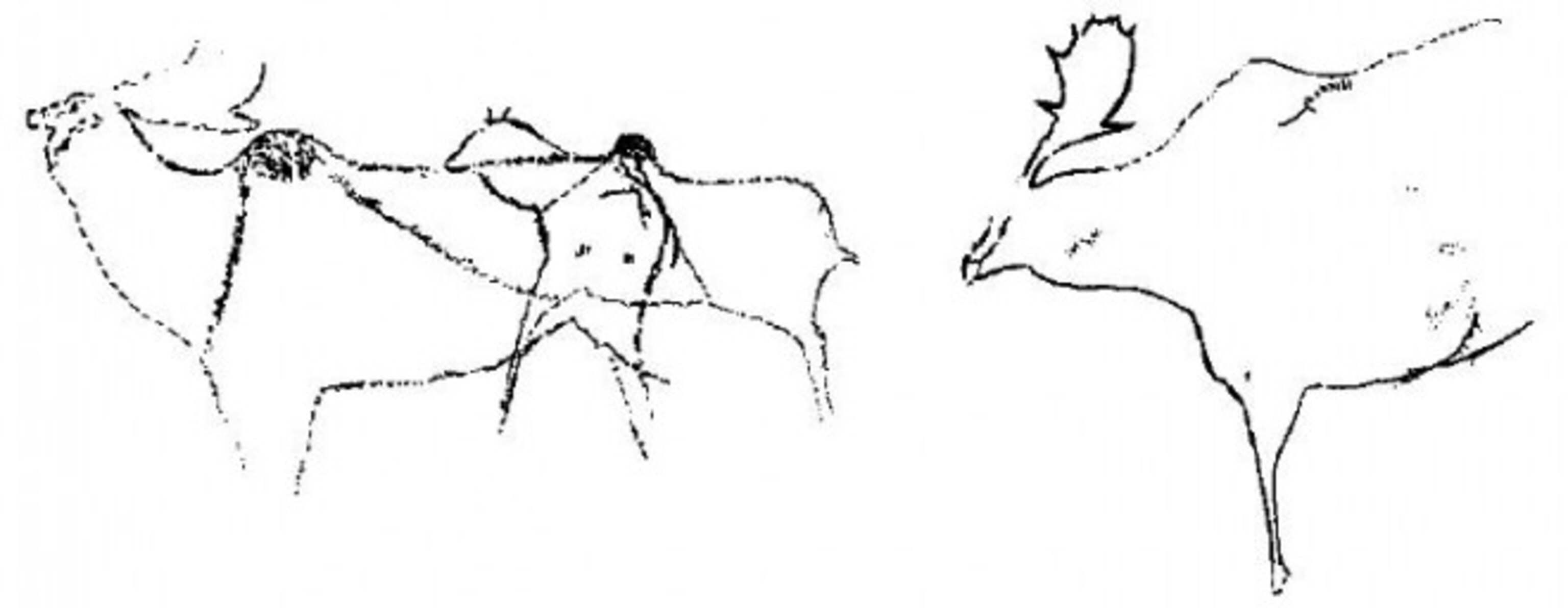[Author’s Note: This week I am driving west with my wife and our three cats to our new apartment in Salt Lake City, Utah. Packing prevented me from writing up anything new, so I’m featuring a few posts from the recent past. I’ll be back to regular blogging next week!]
When craftsman Ken Walker decided to reconstruct an Irish elk for the “recreations” category of the 2005 World Taxidermy Championships, he did not rely on bones alone. Skeletons of the extinct Pleistocene mammal – technically called Megaloceros giganteus – were in no short supply as references, but there are some things that bones just can’t tell you. Cartilage, muscle, fascia, fat, skin, and hair must all be accounted for. Fortunately for Walker, prehistoric artisans etched some valuable information about this animal on stone.
Found in southwestern France’s Cougnac Cave, a rock canvas featuring approximately 25,000 year old drawings of Megaloceros displayed a prominent feature that scientists did not expect. (See above. From Lister, 1994.) Just above the shoulder blades – at the part of the back called the withers – was a large, dark-colored hump. This was not an accident. These drawings had been made from observations of living animals, and the hump was consistently featured in multiple illustrations. There were skeletal clues that the animal had such a feature, mainly a series of elongated spines along the vertebrae of the upper back which are important muscle attachment sites and support humps in other mammals. With this information in hand, Walker gave his Megaloceros a mighty, dark-colored hump. He went on to win the top prize in his category at the competition.
(Woolly mammoths, too, had a large hump at the withers, and this fact also came courtesy of the Upper Paleolithic school of art.)
The hump of Megaloceros was not only of interest to paleoartists, though. Its presence may tell us something about the social lives of these extinct mammals. As paleontologist Adrian Lister pointed out in 1994, such a large and starkly colored hump would have been a component of the animal’s display gestalt,and Stephen Jay Gould considered it to be a good example of exaptation. The hump likely originated as a mass muscle and ligaments which assisted in holding up the heavily-decorated heads of males, Gould argued, but was later co-opted into a distinct part of the animal’s display pattern. (As the cave paintings showed, even females had humps.) A few sketches by prehistoric naturalists acted as windows into the behavior and evolution of a long-dead species.
Megaloceros was just one of many animals to be illustrated by prehistoric humans. Mammoths made for popular motifs, as did horses and deer, but there are other drawings which depict animals of uncertain affinity. A drawing in Australia, for example, may or may not be the extinct marsupial Palorchestesthe extinct marsupial Palorchestes, and even artwork which was once considered to be correctly identified has turned out to be a different sort of creature.

In 1896, a 6-inch stone figure of a big cat was found in Isturitz cave in northern France. Described in 1910, it appeared to be a representation of a cave lion, but the statuette was lost and its identification was forgotten. Upon seeing reproductions of the original figure, though, in 1970 the Czech paleontologist Vratislav Mazak proposed that the cat wasn’t a cave lion at all. Instead its short tail, deep face, and other features identified it as Homotherium latidens, a wide-ranging species of scimitar-toothed cat which was thought to have lived right up until the last global glaciation.
Mazak’s interpretation was interesting, but didn’t last long. Better resolution of recent geologic time showed that Homotherium went extinct before the figure was made and therefore could not have been its inspiration. By default, the figure must have been of a cave lion.
A gap in time had resolved the identity of the Isturitz statue, but in 2003 a team of paleontologists led by Jelle Reumer returned to Mazak’s hypothesis on the basis of new fossil material dredged up from the North Sea. In 2000 a fishing boat had trawled up the lower jaw of Homotherium, and when this jaw was subjected to radiocarbon analysis it yielded a date of about 28,000 years before present. This was geologically youngest evidence of Homotherium latidens ever found, demonstrating that at least some of these rare predators survived until the Late Pleistocene. Since the jaw was about the same age as the figure, Reumer and colleagues considered the new find as a confirmation of what had previously been proposed on the basis of the statuette. After several decades, the artistic record and the fossil record came into accord.

Can we really be sure that the Isturitz figure represents Homotherium and not a cave lion? No, we can’t, and a study published last year by Mauricio Antón and co-authors reassessed Mazak’s reinvigorated hypothesis. In order to do this, they set about restoring the saber-toothed predator as it would have looked in life. In 1998 Antón paired with Rosa Garcia-Perea to resolve a debate about the face of the sabertoothed Smilodon by rigorously reconstructing the soft-tissue anatomy of its head, and last year’s paper from Geobios used the same approach for Homotherium latidens.
Based on fossil skulls from Incarcal, Spain and observations from dissections of several large, extant cats, the scientists reconstructed the skull of Homotherium layer-by-layer. Though possessing the same set of musculoskeletal components, the extinct cat was significantly different from its modern cousins.

Compared to the skull of a lion, Homotherium latidens had a longer snout, a larger nasal opening, an expanded shelf of bone at the back of the skull, zygomatic arches (cheekbones) which did not flare out as widely, and a battery of upper incisor teeth which stuck out more prominently from the teeth behind it. (And, not surprisingly, the upper canine teeth of Homotherium were long enough to stick out from the upper lips when its mouth was closed. Some scientists had hypothesized that sabercats had extra folds of skin around their jaws given their ability to open their mouths exceptionally wide to clear the span of their canines, but Anton and Garcia-Perea convincingly showed that this was not the case in their earlier study of Smilodon.) Overall, Homotherium had a relatively long skull which was narrow from side-to-side but deeper in some parts, such as the lower jaw, and this would have given its head a significantly different shape from that of cave lions and other big cats. Even in terms of body shape, Homotherium latidens would have been a comparatively gracile animal, with a less beefy build than that of a lion and a spine which sloped slightly downwards.
So restored, Homotherium is a pretty poor fit for the Isturiz figure. The figure is of a cat with a relatively stocky build, convex head, short face, and high back. This is more consistent with the appearance of a lion, and, as Antón and his colleagues point out, the apparently deep jaw of the figure could represent the long chin hair of lion rather than indicating a truly deep jaw. Nor does the figure show any sign of long canine teeth, a striking feature whose absence must be accounted for, and there is no reason to believe that the canines would have been covered by lips in life. In fact, the proportionally large eyes and head of the figure may even indicate that it represents a juvenile lion, although the Paleolithic artist who created the sculpture could not be reached for comment on this hypothesis.
The case that the Istruiz figure represents a Homotherium has crumbled. Anatomically speaking, a good deal of inference and special pleading would be required to make the figure consistent with the sabercat, and the new evidence which reinvigorated the Homotherium hypothesis is also questionable. Radiocarbon dates obtained directly from geologically recent bones and teeth have been known to fluctuate significantly from test to test and these procedures are constantly being refined. A second radiocarbon analysis is needed to test the hypothesis that the North Sea Homotherium jaw was as recent as has been proposed. Even if the 28,000 year date is accurate, though, Antón and co-authors are correct that this specimen would represent a rare species during a time when lions were more widespread throughout Europe. Whoever carved the Istruiz figure would have almost certainly been more familiar with cave lions than Homotherium.
I have to admit that I feel a twinge of disappointment about this. A rare representation of one of the last sabercats now appears to be nothing more than a common cave lion. Bones are beautiful, but an artistic representation of a living thing which has entirely vanished is a precious echo of life from an era long past. Lions, though still fearsome, are familiar and have been tamed through pop culture and zoo exhibits, while Homotherium represents a not-so-distant time when the world was still wild and ancient carnivores gave our predecessors good reason to seek refuge in caves at night.
But that’s the way science works. We cannot reconstruct the past simply on the basis of what makes the most compelling story. If we did that, immense sauropod dinosaurs would still be shown dwelling in conveniently-deep swamps and the sail-backed synapsid Edaphosaurus would be restored windsurfing across the surface of Permian lakes. Hypotheses about the history of life on earth are constantly being proposed, tested, tossed out, forgotten, and rediscovered, and our most cherished visions of ancient life are the ones we have to examine with the most care.
Even so, in the case of the Istruiz figure, there is considerable consolation for those who would like to imagine prehistoric humans being stalked by the fleet-footed sabercat. Homotherium was a widespread and long-lived genus of predator – originating in Africa about five million years ago before later spreading to Europe, Asia, and North America – and this means that the sabercat was present during most of human evolutionary history. Our ancestors and close relatives most certainly saw and occasionally fell prey to Homotherium, and the idea that this big cat killed large prey which provided extra leftovers for enterprising humans has made it a central player in ongoing debates about when hominins began to hunt. Whether or not Homotherium gave early humans a hand by being a messy eater with a taste for big game is embedded in a different set of hypotheses and notions, however, and is a tale for another time.
References:
Antón, M., Salesa, M., Turner, A., Galobart, A., & Pastor, J. (2009). Soft tissue reconstruction of Homotherium latidens (Mammalia, Carnivora, Felidae). Implications for the possibility of representations in Palaeolithic art☆ Geobios, 42 (5), 541-551 DOI: 10.1016/j.geobios.2009.02.003
ANTÓN, M., GARCÍA-PEREA, R., & TURNER, A. (1998). Reconstructed facial appearance of the sabretoothed felid Smilodon Zoological Journal of the Linnean Society, 124 (4), 369-386 DOI: 10.1111/j.1096-3642.1998.tb00582.x
Gould, S. (1997). The exaptive excellence of spandrels as a term and prototype Proceedings of the National Academy of Sciences, 94 (20), 10750-10755 DOI: 10.1073/pnas.94.20.10750
LISTER, A. (1994). The evolution of the giant deer, Megaloceros giganteus (Blumenbach) Zoological Journal of the Linnean Society, 112 (1), 65-100 DOI: 10.1006/zjls.1994.1034
REUMER, J., ROOK, L., VAN DER BORG, K., POST, K., MOL, D., & DE VOS, J. (2003). LATE PLEISTOCENE SURVIVAL OF THE SABER-TOOTHED CAT HOMOTHERIUM IN NORTHWESTERN EUROPE Journal of Vertebrate Paleontology, 23 (1), 260-262 DOI: 10.1671/0272-4634(2003)23[260:LPSOTS]2.0.CO;2
For more on sabercats, see:
Q: How do you sex a Smilodon? A: Very CarefullyQ: How do you sex a Smilodon? A: Very CarefullyQ: How do you sex a Smilodon? A: Very Carefully
Broken teeth tell of tough times for SmilodonBroken teeth tell of tough times for Smilodon
Was Smilodon a prehistoric can-opener?Was Smilodon a prehistoric can-opener?Was Smilodon a prehistoric can-opener?

